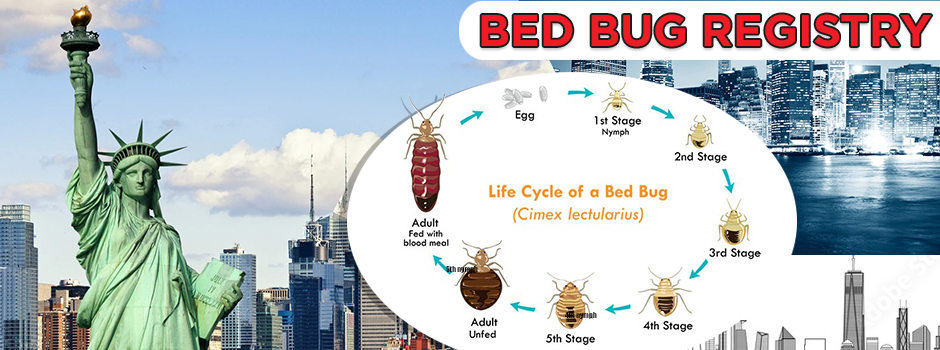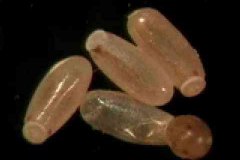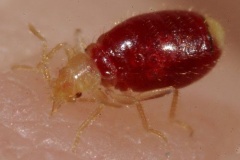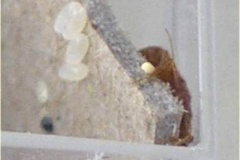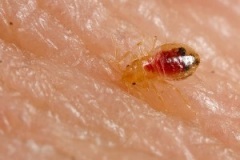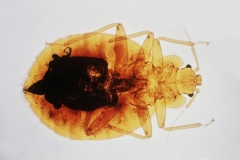Learning how to identify bed bugs will help any home owner or apartment tenant avoid an infestation. All it takes is one pregnant female to produce a population. Bed Bugs do resemble other bugs, so a close inspection is required.
Bed bug appearance will change based on where they are in their life cycle, as they pass through 5 nymph and 1 adult stage. Color and shape can also vary if the bedbug has just had a blood meal and if that meal has been digested. They will appear flat and light brownish if they haven't just eaten and will become reddish after feeding.
Bed bug infestations are increasing across the globe. Reports in many U.S. cities show a 2x increase in complaints over a 2 year period. Reports in Ontario Canada have increased 100%, while Germany has seen a year to year increase of 5 reports to 76 reports.
In its earliest stages bed bugs may be difficult to detect since red bumps on the skin and skin itch, the typical symptom, can have multiple causes. As an infestation grows, repeated bites and stains on the mattress make it obvious that bed bugs are the problem and indicates that you should bring in an expert to identify bed bugs in your home or apartment.
Bed bugs change in appearance depending on where they are in the bed bugs life cycle. A bed bug will pass through five stages before reaching the sixth stage which is adulthood. Baby bed bugs are referred to as nymphs.
The bugs are also difficult to detect since they tend to only leave their hiding places at night, with the only sign being mattress or furniture stains. When an infestation is small, must bugs can be found on or near a bed, hiding on a box spring, backboard on in cracks on a bed frame, particularly wood frames. Always look for light to dark spots which can be shed skins and feces .
At birth they are about 1/16 of an inch and have a light straw color appearance. After a blood meal they will redden in color and appear to be larger. As they get older they become darker in color, taking on a reddish/brown appearance and grow to 1/4 inch.
If you think you have bed bugs, but want to be sure, then you can send a bug you capture to the Cornell Insect Diagnostic Laboratory. The service costs $25.
Bed bugs tend to hide in many places around a room, with most hiding near or around the mattress. The following diagram shows common bed bug hiding places. It is possible to see a solitary bed bug that isn't near the location of the larger infestation.
When trying to identify bed bugs, look in the following places in the typical room:
Here are some bed bug identification tips:
1. Bed Bug Bites: The most telling way to determine if you have bed bugs is if you experience bites while sleeping. Bites can vary from just puncture marks on the skin to large red bumps. The bites themselves are an allergic reaction and vary from person to person. It is possible for the allergic reaction to worsen after each biting episode. When a person is being bitten they may only feel a slight tickle. Bed bugs tend not to bite the face or bottom of the feet.
2. Spots on the Mattress: Red blood smears, brown spots, or pale colored spots (fecal spots) on the mattress along the seams or on sheets, bed sheets or the head board. Look for clusters of spots, particularly on the head board, where the bugs might hide or rest.
3. Look for Bed Bug Eggs; A female will lay clusters of Bed bug eggs along the seams of the mattress and in other parts of the room. These are white pin sized specs that will be glued on to the mattress as the eggs are sticky when laid by a female bed bugs. When looking for a bed bug egg, use a magnifying glass and a bed bug detection flashlight.
4. Bed Bug Odor: Bed bugs sometimes, but not always give off a distinct odor that smells like coriander. The alarm pheromone is not always produced so bugs or rooms infested by them don't always smell like this. However, bed bug dogs can pick up odors that humans cannot.
5. Seeing the bugs themselves on the mattress: 90% will be near or around the bed.
6. Create Your Own Bed Bug Trap: Rutgers University Scientists have devised a simple make at home trap that can help you identify bed bugs (Science News, Jan. 16, 2010).
Start by putting 2.5 lbs. or dry eyes in a 1/3 gallon jug. A cooler (eg; Coleman type) with a flip top will be best. Leave the spout open a bit, so that as carbon dioxide is released, it leaves the container. Put the cooler in the center of a bowl such as a pet food dish. Tape a piece of paper to the outside of the dish.
The bed bugs will be attracted to the carbon dioxide, climb up the side of the dish or bowl and then get trapped inside. Place some talcum powder into the dish, which will kill the bed bugs when it sticks to the insect's back. This home made bed bugs trap should work within 12 hours if you have bed bugs.
As an alternative, you can buy a Climbup Interceptor (pictured below), and place one under each leg of the bed. This will work the same way, and trap any bed bugs heading toward the bed and the human host.
Bed bugs are oval in appearance and can look like a tick or small cockroach. They follow a life cycle where they change in appearance. They appear to be flat if unfed or far on in digesting a blood meal. Atfirst, Instars are whitish and yellowish or straw-colored and nymphs (young bed bugs) will be plump and red if they have taken a blood meal. They are not so red in color if digesting the meal.
After a meal a bed bug will become enlarged by approximately 30%.
There are 92 species of bed bugs in the world, with 16 of the 92 found in the United States. Sometimes it is very difficult to identify bed bugs vs. other bugs. These include:
Bugs vary by their natural host and where they are found. Several bugs need to be collected and examined by a pest control specialist in order to confirm that an infestation exists.
A pest control expert will have the experience for how to identify bed bugs. We suggest starting with a call to Home Advisor (1.877-233-1145), which is a network of local pest control experts that are pre-screened by the network before being accepted as members. They will provide up to 4 free quotes and certify that each member is licensed and insured.
You can also search our database of local bed bug experts here. If you'd like to read consumer reviews of bedbug exterminators in your area, a helpful service is Angie's List.
Someone that frequently treats bed bugs infestations will know where in a home or apartment to look for hiding bugs. Expect to pay $50 to $500 for an on site inspection ($500 is a dog is used) plus the cost of the treatment which can cost $750 or more.
As an alternative, a do it yourself kit, containing the multiple products you need, such as the one offered by Naturasil for Bed Bugs (uses organic methods) or Bed Bug Supply (insecticide based) will cost $160 for everything you need (spray, steamer, fossil dust, mattress covers).
Each of these free brochures provide additional information on how to identify bed bugs in your home or apartment.
How to Identify Bed Bugs
Tips on how to identify bed bugs in your home, office or when traveling..
Written by: Dini M. Miller, Ph.D.
Available in a free Ebook
Bed Bug Identification and Inspection
One page summary of how to identify bed bugs and inspect your home, apartment, office or hotel room.
Written by: Illinois Department of Public Health
Available in a free Ebook
Do you have a question or great story about bed bugs? Share it!
Click below to see contributions from other visitors to this page...
Continued here:
Identify Bed Bugs: Pictures and Descriptions

 Residence
Residence  Location
Location 
